
Wine Culture and Information since 2002 - Volume 22
 Wine Culture and Information since 2002 - Volume 22 |
|
Contrasts of Asolo Prosecco Spumante and Colli Euganei Fior d'Arancio SpumanteTwo famous sparkling wines from Veneto compared in the glasses of this summer's tasting by contrast. Two very different grapes for two equally different wines |
|
In summer, when we need to face the inevitable rise in temperatures, wine lovers are certainly happy to uncork bottles of white wines and, not least, sparkling wines, either produced with the classic method or with the Charmat or Martinotti method. From this point of view, the Italian wine scene – from Valle d'Aosta to Sicily – offers a vast choice of bubbles, from extremely simple and light to those complex and of good structure. The discriminating factor is not only the production method used for the refermentation of a wine – the closed tank for the Charmat method, the bottle for the classic one – but also, and above all, the grape or grapes used for the production of the base wine. In this regard, it should be considered not all grapes are suitable for the production of a sparkling wine and that, in any case, it is a choice that begins from the vineyard and the careful evaluation of the ripening cycle. It must in fact be considered the wine that will later become sparkling must have a marked acidity and a “modest” alcohol by volume. Furthermore, if the sparkling wine is going to be produced with red berried grapes, it is necessary to further evaluate the astringency as well as the vinification method, that is “in red” or “in white”. Veneto offers an interesting range of sparkling wines and, of which, the most famous and representative one is undoubtedly the Conegliano-Valdobbiadene Prosecco, also thanks to the impressive number of bottles produced. The tasting by contrast of this summer, however, will not examine this famous sparkling wine, but two other very interesting representatives of the Veneto sparkling wine scene: Asolo Prosecco Spumante and Colli Euganei Fior d'Arancio Spumante. The first is produced in the homonymous village in the province of Treviso with Glera grape – once better known as “Prosecco” – the second is produced in the province of Padua with Moscato Giallo grape. Both wines are then usually produced with the refermentation in closed tank.
|
|
The Glera grape – until a few years ago known everywhere as Prosecco – is certainly among the most widespread varieties in Veneto and widely used for the production of sparkling wines in the region. This variety is present in many Denominazione d'Origine Controllata areas (Controlled Denomination of Origin, DOC) of Veneto and, in the case of the vast production area of Prosecco DOC, also in Friuli Venezia Giulia. Of all the appellation areas that provides for the use Glera grape for the production of sparkling wines, only two have achieved the highest level of the Italian quality system, the Denominazione d'Origine Controllata e Garantita (Denomination of Controlled and Guaranteed Origin, DOCG): Conegliano-Valdobbiadene Prosecco and Asolo Prosecco. Both wines are generally produced by refermentation in closed tank, using the Charmat or Martinotti method. The main variety is Glera which, in both cases, must make up at least 85% of the composition. As for Asolo Prosecco, the remaining 15% can be composed of Verdiso, Bianchetta Trevigiana, Perera and Glera Lunga grapes, alone or together. Asolo Prosecco, also known as “Colli Asolani Prosecco”, is produced in the territory that extends around the town of the same name in the province of Treviso. Asolo Prosecco is produced in the wine style (that is, still table wine), slightly sparkling, sparkling and aromatic sparkling wine. These last categories can also show in label “sui lieviti” (on the lees), in case the sparkling wine was directly refermented in the bottle and without having carried out the disgorgement. In general terms, Asolo Prosecco Spumante – that is the style we will examine in our tasting by contrast – allows the production of styles determined by residual sugar and going from brut to demi sec. As for the “on the lees” type, the only style allowed is brut nature. Finally, for the sparkling wine typology, Pinot Blanc, Pinot Noir, Pinot Gris and Chardonnay varieties are also allowed for production – for a maximum of 15% – alone or together. In this regard, however, it should be noted that very often producers tend to use Glera grape alone.
|
||||
|
In the Italian panorama of sparkling wines from aromatic grapes, there is a pearl of absolute value and it is produced in the Colli Euganei area, in the province of Padua. We are of course talking about “Fior d'Arancio” (orange blossom), the famous sparkling wine from Veneto with exuberant aromas of fruits and flowers produced with Moscato Giallo grape (Yellow Muscat), locally called Fior d'Arancio. The wines produced with this grape in the territory of the Colli Euganei, in fact, express very pleasing aromas reminiscent of orange blossom. The history of Moscato Fior d'Arancio is fascinating and its presence in this territory of the province of Padua is long and well rooted. It is also said that – in the past – the must of this grape was being made “sparkling” directly in the bottle, with the method we now call ancestral or rural method. Today it is mainly produced using the Martinotti method, using – today as then – the Moscato Giallo grape. Colli Euganei Fior d'Arancio is a Denominazione d'Origine Controllata e Garantita wine (Denomination of Controlled and Guaranteed Origin, DOCG) and, in addition to the sweet sparkling version, there is also a “still” and passito style, made with dried grapes. In all cases, the production disciplinary provides for the use of Moscato Giallo for at least 95% of the composition, while the remaining part can be represented by other aromatic white grape varieties allowed to the cultivation in the province of Padua. The Colli Euganei Fior d'Arancio Spumante is characterized, in addition to its marked sweetness, by an alcoholic volume of at least 6%. Colli Euganei Fior d'Arancio Spumante is a wine with a strong sensorial personality, especially for its aromas which make it practically unique in the scenario of aromatic sparkling wines. Although the production of wine in the Colli Euganei area boasts a long history of centuries – white and red table wines are also produced here – today it is the “Fior d'Arancio” which, undeniably, mainly represents the enology of these lands.
|
We are about to start the tasting by contrast of this summer and, therefore, we will proceed with the choice of the two bottles to be poured into the glasses. The availability of Asolo Prosecco Spumante and Colli Euganei Fior d'Arancio Spumante does not present, in general terms, particular difficulties as they are both easy to find in specialized wine shops. In choosing the two wines, however, we will pay attention to their composition, by considering that, according to the respective production disciplinary, the two primary grapes – Glera for Asolo Prosecco Spumante, Moscato Giallo for Colli Euganei Fior d'Arancio Spumante – can be blended to other grapes. For this reason we will make sure that, in both cases, the two main grapes are also the only ones used for their production. We will also choose wines produced with the Martinotti method – therefore in closed tank – and belonging to the most recent vintage. Regarding the style of Asolo Prosecco Spumante, our choice will be in favor of extra dry, while for Colli Euganei Fior d'Arancio Spumante the choice is in favor of the sweet style. Asolo Prosecco Spumante and Colli Euganei Fior d'Arancio Spumante are poured into their respective tasting glasses and served at a temperature of 10 °C. (50 °F) Let's pour Asolo Prosecco Spumante and Colli Euganei Fior d'Arancio Spumante into their respective glasses and begin the evaluation of the appearance of the two wines. The first wine we examine is Asolo Prosecco Spumante Extra Dry. By holding the glass in vertical position, we observe the quality of the bubbles which are very fine and develop upwards for a long time. The color of Asolo Prosecco Spumante Extra Dry – evaluated after tilting the glass over a white surface – is brilliant greenish yellow and the nuance, observed at the edge of the glass, towards the opening, confirms the same color. Let's now pass to the evaluation of the effervescence of Colli Euganei Fior d'Arancio Spumante, by holding the glass in vertical position: also in this case the bubbles are fine and very small, developing a continuous and persistent upward chain. The color of this wine, after having tilted the glass over the white surface, shows a brilliant straw yellow color, sometimes tending to gold. The nuance – observed at the edge of the glass – confirms the same color. The olfactory profiles of Asolo Prosecco Spumante and Colli Euganei Fior d'Arancio Spumante are clearly distinguished by deep and distant differences. Although the production method is the same in both cases – the wines are made in closed tank according to the Charmat or Martintti method – the two wines are characterized by the sensorial qualities of their respective grapes: Glera for Asolo Prosecco Spumante, Moscato Giallo for Colli Euganei Fior d'Arancio Spumante. In the glass of Asolo Prosecco Spumante can be perceived intense and clean aromas of wisteria, apple, pear and peach, to which are often added hawthorn, broom, tangerine, plum and exotic fruit, in particular pineapple. As for the olfactory profile of Colli Euganei Fior d'Arancio Spumante, the aromatic exuberance of Moscato Giallo is the dominant quality that can be perceived from the glass, therefore a clean and intense aroma of fresh grapes. Moreover, in this wine, can be perceived aromas reminiscent of flowers such as white rose, jasmine and broom. As for the aromas associated to fruit sensations, in addition to grape, in Colli Euganei Fior d'Arancio Spumante can be perceived apple, pear, peach, citron and tangerine, as well as sensations reminiscent of tropical fruit, in particular mango and banana. Let's continue the tasting by contrast, proceeding with the analysis of the olfactory profiles of the two wines. Just like for the previous phase, the first wine of which we examine the aromas is Asolo Prosecco Spumante Extra Dry. Let's hold the glass in vertical position and, without swirling, let's proceed with the first smell in order to evaluate the opening of the wine, that is its identifying sensations. From the glass are perceived – clean and intense – the aromas of apple, pear, peach and wisteria, the latter very frequent and identifying for sparkling wines produced with Glera grape. After having swirled the glass and proceeded with a second smell, Asolo Prosecco Spumante Extra Dry completes its olfactory profile with hawthorn, citrus fruits – frequently cedar and tangerine – broom, plum and pineapple. Let's now pass to the evaluation of the olfactory profile of Colli Euganei Fior d'Arancio Spumante, starting from the opening of the wine. From the glass can be perceived the characteristic aroma of fresh grape as well as apple, pear and white rose. After having swirled the glass, the profile of the wine is completed with peach, broom, mango, tangerine and jasmine. The sensorial differences of the two wines continue to emerge also when evaluating their respective gustatory profiles. Let's take a sip of Asolo Prosecco Spumante Extra Dry and evaluate its attack, that is, the initial sensations the wine expresses in the mouth. The effervescence of the wine is immediately perceived as well as the marked crispness of acidity, followed soon after by a perceptible sweetness, creating a perfect balance of sensorial elements. In the mouth are clearly perceived the flavors of apple, peach, pear and pineapple. Let's now take a sip of Colli Euganei Fior d'Arancio Spumante and evaluate its attack. In the mouth can be perceived the pungent effect of the effervescence produced by carbon dioxide and, compared to the previous wine, a sensation of evident sweetness, immediately followed by the crispness given by acidity. Also in this case the balance of the various elements is very good and in the mouth are perceived the flavors of grape, apple, peach, mango and tangerine. Let's now compare the effect and perception of alcohol in the two wines, in particular in Colli Euganei Fior d'Arancio Spumante, which has a decidedly lower alcohol volume than Asolo Prosecco Spumante Extra Dry. We conclude our tasting by contrast by evaluating the final sensations the two wines leave in the mouth after swallowing, in particular the taste-olfactory persistence, primary element for evaluating the quality of a wine. The finish of Asolo Prosecco Spumante Extra Dry is persistent, leaving in the mouth pleasing flavors of apple, pear, peach and pineapple, as well as the gentle sensation of sweetness and crispness. The finish of Colli Euganei Fior d'Arancio Spumante is equally persistent, however here the perception of sweetness is decidedly more marked than the previous wine, however well balanced by acidity. The wine leaves in the mouth pleasing and intense flavors of grape – of grape juice, in particular – as well as banana, pear, peach, apple and mango. Before concluding our tasting, let's place the glasses side by side and, without swirling, let's do a last smell. Note, in particular, the characteristic aromaticity of Moscato Giallo – which is expressed with the clean scent of grape juice – almost absent in the wine produced with Glera.
|
||||||||
Wines of the Month |
|
|
|
Score legend Prices are to be considered as indicative. Prices may vary according to the country or the shop where wines are bought |
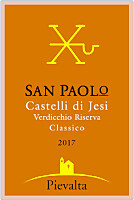
|
|
Castelli di Jesi Verdicchio Riserva Classico San Paolo 2017 |
|
| Pievalta (Marches, Italy) | |
 Verdicchio Verdicchio | |
| Price: € 16.00 | Score: |
 Brilliant straw yellow and nuances of straw yellow, very transparent. Brilliant straw yellow and nuances of straw yellow, very transparent. Intense, clean, pleasing, refined and elegant, starts with hints of
apple, plum and hawthorn followed by aromas of pear, almond, broom, citrus
fruits, pear, anise, honey, thyme and flint. Intense, clean, pleasing, refined and elegant, starts with hints of
apple, plum and hawthorn followed by aromas of pear, almond, broom, citrus
fruits, pear, anise, honey, thyme and flint.
 Crisp attack and however balanced by alcohol, good body, intense
flavors, pleasing roundness. Crisp attack and however balanced by alcohol, good body, intense
flavors, pleasing roundness.
 Persistent finish with flavors of apple, plum and almond. Persistent finish with flavors of apple, plum and almond. 20 months in steel tanks, 13 months in bottle. 20 months in steel tanks, 13 months in bottle. |
|
 Stuffed pasta with mushrooms, Roasted fish, Roasted white meat, Stewed fish with mushrooms Stuffed pasta with mushrooms, Roasted fish, Roasted white meat, Stewed fish with mushrooms |
|
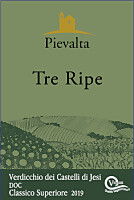
|
|
Verdicchio dei Castelli di Jesi Classico Superiore Tre Ripe 2019 |
|
| Pievalta (Marches, Italy) | |
 Verdicchio Verdicchio | |
| Price: € 8.50 | Score: |
 Intense straw yellow and nuances of straw yellow, very transparent. Intense straw yellow and nuances of straw yellow, very transparent. Intense, clean, pleasing and refined, starts with hints of apple, plum
and hawthorn followed by aromas of pear, citrus fruits, peach, broom,
linden and almond. Intense, clean, pleasing and refined, starts with hints of apple, plum
and hawthorn followed by aromas of pear, citrus fruits, peach, broom,
linden and almond.
 Crisp attack and however balanced by alcohol, good body, intense
flavors, agreeable. Crisp attack and however balanced by alcohol, good body, intense
flavors, agreeable.
 Persistent finish with flavors of apple, plum and almond. Persistent finish with flavors of apple, plum and almond. 7 months in steel tanks, 1 month in bottle. 7 months in steel tanks, 1 month in bottle. |
|
 Pasta with fish, Sauteed white meat, Sauteed fish, Fried fish Pasta with fish, Sauteed white meat, Sauteed fish, Fried fish |
|
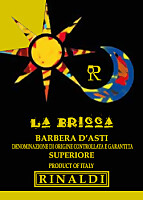
|
|
Barbera d'Asti Superiore La Bricca 2016 |
|
| Rinaldi (Piedmont, Italy) | |
 Barbera Barbera | |
| Price: € 15.00 | Score: |
 Intense ruby red and nuances of garnet red, little transparency. Intense ruby red and nuances of garnet red, little transparency. Intense, clean, pleasing and refined, starts with hints of cherry, plum
and dried violet followed by aromas of blackberry, blueberry, cocoa,
tobacco, mace, licorice, vanilla and menthol. Intense, clean, pleasing and refined, starts with hints of cherry, plum
and dried violet followed by aromas of blackberry, blueberry, cocoa,
tobacco, mace, licorice, vanilla and menthol.
 Properly tannic attack and however balanced by alcohol, good body,
intense flavors, agreeable. Properly tannic attack and however balanced by alcohol, good body,
intense flavors, agreeable.
 Persistent finish with flavors of cherry, plum and blackberry. Persistent finish with flavors of cherry, plum and blackberry. At least 12 months in cask. At least 12 months in cask. |
|
 Stuffed pasta with meat, Roasted meat, Stewed meat with mushrooms, Hard cheese Stuffed pasta with meat, Roasted meat, Stewed meat with mushrooms, Hard cheese |
|

|
|
Monferrato Rosso Panta Rei 2017 |
|
| Rinaldi (Piedmont, Italy) | |
 Barbera (50%), Cabernet Sauvignon (50%) Barbera (50%), Cabernet Sauvignon (50%) | |
| Price: € 20.00 | Score: |
 Intense ruby red and nuances of garnet red, little transparency. Intense ruby red and nuances of garnet red, little transparency. Intense, clean, pleasing and refined, starts with hints of cherry, plum
and black currant followed by aromas of dried violet, blueberry, carob,
chocolate, tobacco, cinnamon and vanilla. Intense, clean, pleasing and refined, starts with hints of cherry, plum
and black currant followed by aromas of dried violet, blueberry, carob,
chocolate, tobacco, cinnamon and vanilla.
 Properly tannic attack and however balanced by alcohol, good body,
intense flavors, pleasing roundness. Properly tannic attack and however balanced by alcohol, good body,
intense flavors, pleasing roundness.
 Persistent finish with flavors of cherry, plum and black currant. Persistent finish with flavors of cherry, plum and black currant. Aged inn cask. Aged inn cask. |
|
 Broiled meat and barbecue, Roasted meat, Stewed meat with mushrooms, Cheese Broiled meat and barbecue, Roasted meat, Stewed meat with mushrooms, Cheese |
|
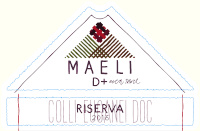
|
|
Colli Euganei Rosso Riserva D+ 2016 |
|
| Maeli (Veneto, Italy) | |
 Merlot (60%), Cabernet Sauvignon (25%), Carménère (15%) Merlot (60%), Cabernet Sauvignon (25%), Carménère (15%) | |
| Price: € 23.50 | Score: |
 Intense ruby red and nuances of garnet red, little transparency. Intense ruby red and nuances of garnet red, little transparency. Intense, clean, pleasing, refined and elegant, starts with hints of
black currant, black cherry and plum followed by aromas of violet,
blueberry, iris, cocoa, tobacco, cinnamon, mace, cardamom, vanilla and
eucalyptus. Intense, clean, pleasing, refined and elegant, starts with hints of
black currant, black cherry and plum followed by aromas of violet,
blueberry, iris, cocoa, tobacco, cinnamon, mace, cardamom, vanilla and
eucalyptus.
 Properly tannic attack and however balanced by alcohol, good body,
intense flavors, pleasing roundness. Properly tannic attack and however balanced by alcohol, good body,
intense flavors, pleasing roundness.
 Persistent finish with flavors of black currant, black cherry and plum. Persistent finish with flavors of black currant, black cherry and plum. 24 months in barrique, 6 months in steel tanks, 6 months in cement
tanks. 24 months in barrique, 6 months in steel tanks, 6 months in cement
tanks.
|
|
 Roasted meat, Stewed meat with mushrooms, Broiled meat and barbecue, Hard cheese Roasted meat, Stewed meat with mushrooms, Broiled meat and barbecue, Hard cheese |
|
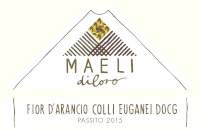
|
|
Colli Euganei Fior d'Arancio Passito Diloro 2015 |
|
| Maeli (Emilia-Romagna, Italy) | |
 Moscato Giallo Moscato Giallo | |
| Price: € 23.00 - 375ml | Score: |
 Brilliant amber yellow and nuances of golden yellow, transparent. Brilliant amber yellow and nuances of golden yellow, transparent. Intense, clean, pleasing, refined and elegant, starts with hints of
raisin, lychee and lavender followed by aromas of candied fruits, dried
apricot, peach jam, orange blossom, white rose, sage, date, honey, almond,
oregano and nail polish. Intense, clean, pleasing, refined and elegant, starts with hints of
raisin, lychee and lavender followed by aromas of candied fruits, dried
apricot, peach jam, orange blossom, white rose, sage, date, honey, almond,
oregano and nail polish.
 Sweet and round attack, however balanced by alcohol, good body, intense
flavors, pleasing crispness. Sweet and round attack, however balanced by alcohol, good body, intense
flavors, pleasing crispness.
 Persistent finish with flavors of raisin, lychee and dried apricot. Persistent finish with flavors of raisin, lychee and dried apricot. 2 years in steel tanks. 2 years in steel tanks. |
|
 Confectionery, Hard and piquant cheese Confectionery, Hard and piquant cheese |
|
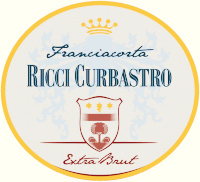
|
|
Franciacorta Extra Brut 2015 |
|
| Ricci Curbastro (Lombardy, Italy) | |
 Chardonnay (50%), Pinot Nero (50%) Chardonnay (50%), Pinot Nero (50%) | |
| Price: € 27.00 | Score: |
 Brilliant straw yellow and nuances of straw yellow, very transparent,
fine and persistent perlage. Brilliant straw yellow and nuances of straw yellow, very transparent,
fine and persistent perlage.
 Intense, clean, pleasing, refined and elegant, starts with hints of
apple, banana and bread crust followed by aromas of tangerine, plum,
grapefruit, praline, pear, honey, butter, almond, flint and hints of
vanilla. Intense, clean, pleasing, refined and elegant, starts with hints of
apple, banana and bread crust followed by aromas of tangerine, plum,
grapefruit, praline, pear, honey, butter, almond, flint and hints of
vanilla.
 Effervescent and crisp attack, however balanced by alcohol, good body,
intense flavors, agreeable. Effervescent and crisp attack, however balanced by alcohol, good body,
intense flavors, agreeable.
 Persistent finish with flavors of apple, banana and grapefruit. Persistent finish with flavors of apple, banana and grapefruit. A small part of the base wine ages in cask. Refermented in bottle and
aged on its lees for about 42 months. A small part of the base wine ages in cask. Refermented in bottle and
aged on its lees for about 42 months.
|
|
 Pasta and risotto with fish and crustaceans, Sauteed white meat, Sauteed crustaceans, Roasted fish Pasta and risotto with fish and crustaceans, Sauteed white meat, Sauteed crustaceans, Roasted fish |
|
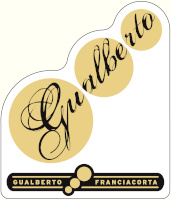
|
|
Franciacorta Dosaggio Zero Gualberto 2010 |
|
| Ricci Curbastro (Lombardy, Italy) | |
 Pinot Nero (65%), Chardonnay (35%) Pinot Nero (65%), Chardonnay (35%) | |
| Price: € 40.00 | Score: |
 Brilliant straw yellow and nuances of straw yellow, very transparent,
fine and persistent perlage. Brilliant straw yellow and nuances of straw yellow, very transparent,
fine and persistent perlage.
 Intense, clean, pleasing, refined and elegant, starts with hints of
apple, plum and bread crust followed by aromas of hawthorn, banana,
grapefruit, hazelnut, tangerine, melon, croissant, pear, peach, almond,
butter, honey, praline, mineral and hints of vanilla. Intense, clean, pleasing, refined and elegant, starts with hints of
apple, plum and bread crust followed by aromas of hawthorn, banana,
grapefruit, hazelnut, tangerine, melon, croissant, pear, peach, almond,
butter, honey, praline, mineral and hints of vanilla.
 Effervescent and crisp attack, however balanced by alcohol, good body,
intense flavors, agreeable. Effervescent and crisp attack, however balanced by alcohol, good body,
intense flavors, agreeable.
 Very persistent finish with long flavors of apple, plum and hazelnut. Very persistent finish with long flavors of apple, plum and hazelnut. Part of the base wine ferments in cask. Refermented in bottle on its
lees for 60 months. Part of the base wine ferments in cask. Refermented in bottle on its
lees for 60 months.
|
|
 Pasta with fish and mushrooms, Roasted fish, Roasted white meat, Stewed fish Pasta with fish and mushrooms, Roasted fish, Roasted white meat, Stewed fish |
|

|
|
Valle d'Aosta Torrette Superiore 2015 |
|
| La Source (Vallée d'Aoste, Italy) | |
 Petit Rouge (90%), Fumin (10%) Petit Rouge (90%), Fumin (10%) | |
| Price: € 16.00 | Score: |
 Intense ruby red and nuances of garnet red, little transparency. Intense ruby red and nuances of garnet red, little transparency. Intense, clean, pleasing and refined, starts with hints of cherry,
raspberry and geranium followed by aromas of strawberry, plum, blueberry,
tobacco, chocolate, vanilla and menthol. Intense, clean, pleasing and refined, starts with hints of cherry,
raspberry and geranium followed by aromas of strawberry, plum, blueberry,
tobacco, chocolate, vanilla and menthol.
 Properly tannic attack and however balanced by alcohol, good body,
intense flavors, agreeable. Properly tannic attack and however balanced by alcohol, good body,
intense flavors, agreeable.
 Persistent finish with flavors of cherry, raspberry and plum. Persistent finish with flavors of cherry, raspberry and plum. 12 months in cask, 12 months in bottle. 12 months in cask, 12 months in bottle. |
|
 Stuffed pasta with meat, Broiled meat and barbecue, Stewed meat with mushrooms Stuffed pasta with meat, Broiled meat and barbecue, Stewed meat with mushrooms |
|

|
|
Valle d'Aosta Chardonnay 2016 |
|
| La Source (Vallée d'Aoste, Italy) | |
 Chardonnay Chardonnay | |
| Price: € 13.00 | Score: |
 Intense golden yellow and nuances of golden yellow, very transparent. Intense golden yellow and nuances of golden yellow, very transparent. Intense, clean, pleasing, refined and elegant, starts with hints of
banana, apple and acacia followed by aromas of pear, hawthorn, citron,
praline, grapefruit, broom, honey, butter and hints of vanilla. Intense, clean, pleasing, refined and elegant, starts with hints of
banana, apple and acacia followed by aromas of pear, hawthorn, citron,
praline, grapefruit, broom, honey, butter and hints of vanilla.
 Crisp attack and however balanced by alcohol, good body, intense
flavors, pleasing roundness. Crisp attack and however balanced by alcohol, good body, intense
flavors, pleasing roundness.
 Persistent finish with flavors of banana, apple and citron. Persistent finish with flavors of banana, apple and citron. A small part ferments in barrique. 9 months in steel tanks, 9 months in
bottle. A small part ferments in barrique. 9 months in steel tanks, 9 months in
bottle.
|
|
 Pasta with legumes, Roasted fish, Stewed white meat with mushrooms, Roasted white meat Pasta with legumes, Roasted fish, Stewed white meat with mushrooms, Roasted white meat |
|
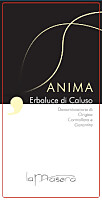
|
|
Erbaluce di Caluso Anima 2018 |
|
| La Masera (Piedmont, Italy) | |
 Erbaluce Erbaluce | |
| Price: € 10.40 | Score: |
 Brilliant golden yellow and nuances of straw yellow, very transparent. Brilliant golden yellow and nuances of straw yellow, very transparent. Intense, clean, pleasing and refined, starts with hints of green apple,
plum and hawthorn followed by aromas of peach, pear, citrus fruits, fern,
hazelnut and mineral. Intense, clean, pleasing and refined, starts with hints of green apple,
plum and hawthorn followed by aromas of peach, pear, citrus fruits, fern,
hazelnut and mineral.
 Crisp attack and however balanced by alcohol, good body, intense
flavors, pleasing roundness. Crisp attack and however balanced by alcohol, good body, intense
flavors, pleasing roundness.
 Persistent finish with flavors of green apple, plum and hazelnut. Persistent finish with flavors of green apple, plum and hazelnut. 6 months in steel tanks, 6 months in bottle. 6 months in steel tanks, 6 months in bottle. |
|
 Fish appetizers, Pasta with fish, Sauteed fish, Sauteed white meat Fish appetizers, Pasta with fish, Sauteed fish, Sauteed white meat |
|
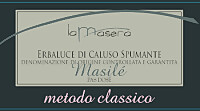
|
|
Erbaluce di Caluso Spumante Metodo Classico Pas Dosé Masilé 2015 |
|
| La Masera (Piedmont, Italy) | |
 Erbaluce Erbaluce | |
| Price: € 21.50 | Score: |
 Brilliant straw yellow and nuances of straw yellow, very transparent,
fine and persistent perlage. Brilliant straw yellow and nuances of straw yellow, very transparent,
fine and persistent perlage.
 Intense, clean, pleasing and refined, starts with hints of apple, plum
and citrus fruits followed by aromas of bread crust, pear, hawthorn,
pineapple, broom, peach, hazelnut and thyme. Intense, clean, pleasing and refined, starts with hints of apple, plum
and citrus fruits followed by aromas of bread crust, pear, hawthorn,
pineapple, broom, peach, hazelnut and thyme.
 Effervescent and crisp attack, however balanced by alcohol, good body,
intense flavors, agreeable. Effervescent and crisp attack, however balanced by alcohol, good body,
intense flavors, agreeable.
 Persistent finish with flavors of apple, plum and hazelnut. Persistent finish with flavors of apple, plum and hazelnut. Refermented in bottle on its lees for 36 months. Refermented in bottle on its lees for 36 months. |
|
 Pasta with fish, Stewed fish with mushrooms, Roasted white meat, Mushroom soups Pasta with fish, Stewed fish with mushrooms, Roasted white meat, Mushroom soups |
|
|
||||||||
|
DiWineTaste Polls
|
| |||||||
Privacy Policy | |||||||


| Copyright © 2002-2024 Antonello Biancalana, DiWineTaste - All rights reserved |
| All rights reserved under international copyright conventions. No part of this publication and of this WEB site may be
reproduced or utilized in any form or by any means, electronic or mechanical, without permission in writing from DiWineTaste. |